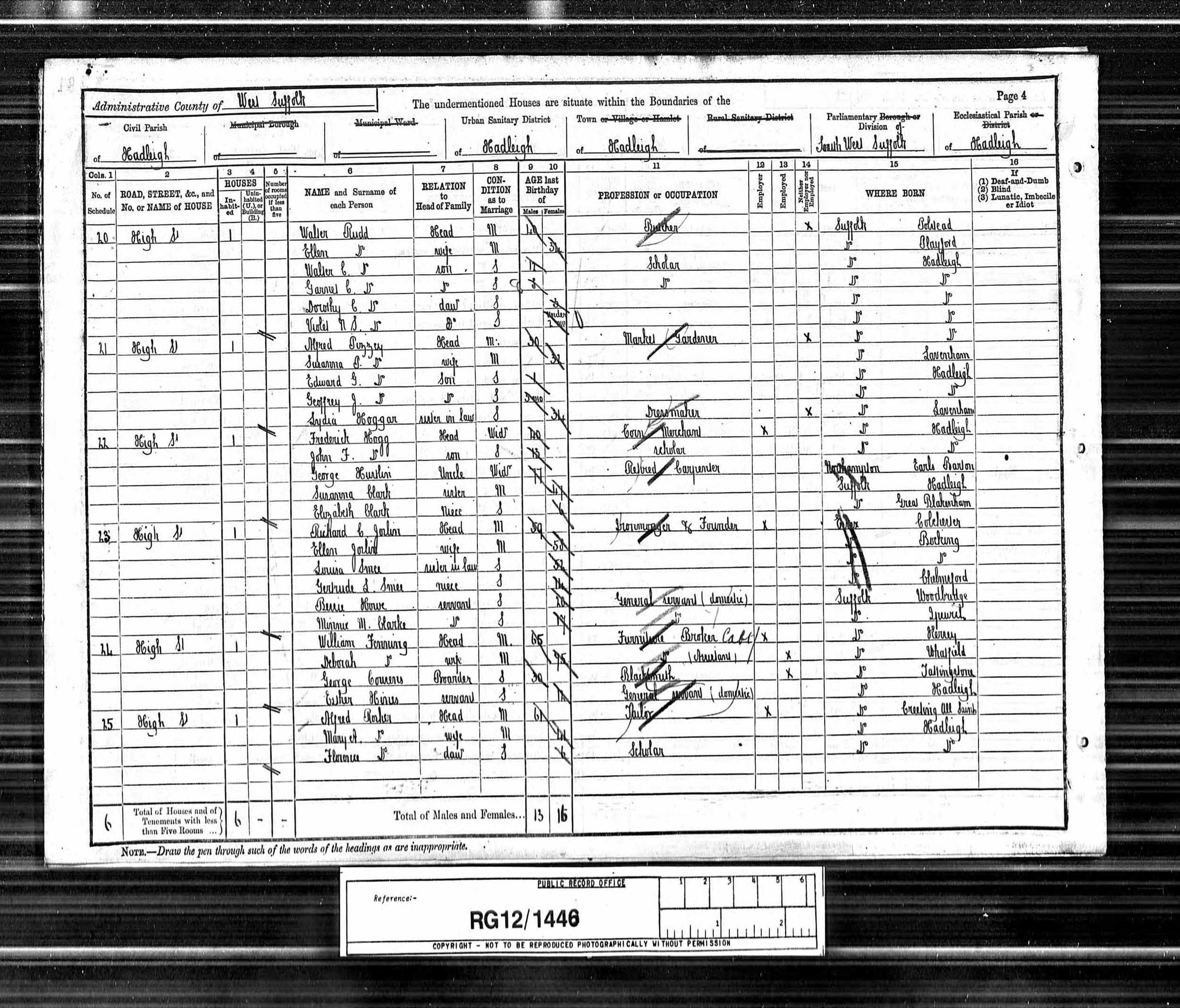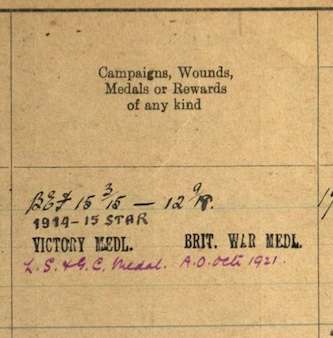Walter Charles Rudd
Rank: Serjeant
Service Number: 313616
Date of Birth: 1879
Regiment: 9th (Queen’s Royal) Lancers
Date of Death: 16 February 1921
Age at death: 42
Cemetery: Hadleigh
Country: England (died in Ireland)
Grave / Reference: Section 37. Grave 47.
Relatives: Husband of Bessie Florence Whatling.
Address: 54 High Street, Hadleigh.
The story of Walter Charles Rudd was almost lost forever. It is thanks to the work of the ‘In From The Cold Project’ that we discovered that Walter existed. Further research has been able to discover a fascinating story of a young Hadleigh man who served his country over many years. Walter was born in Hadleigh in 1879 and was the oldest son of Walter and Ellen Rudd.
Serjeant Walter Charles Rudd.
By 1891, Walter and Ellen were living on the High Street (probably at 88) with their children; Walter Charles (12), Garnel Cario (8), Dorothy Christabel (3) and Violet Nellie Snowdrop who was just two months old.
1891 Census
Just eight years later in 1897 and at the age of 18, Walter enlisted into the 1st Dragoons and was allocated the regimental number of 4104. He was then transferred to the 9th Queens Royal Lancers in September 1898 and went straight out to join the regiment in India, where he and the Lancers remained until the outbreak of the South African War in 1899. In September 1899 the Lancers were deployed to South Africa.
The 9th Lancers remained in South Africa throughout the South African War and during that time, Walter saw action in many key battles. His service record shows that he was awarded the Queen’s (Victoria) South Africa Medal with the following clasps; Belmont, Moddar River, Paardeberg, Johannesburg, Diamond Hill, Wittibergh and Kimberley. He was also awarded the King’s (Edward VII) South Africa medal with the following clasps; SA1901 and SA1902. Before Walter left South Africa he was promoted to Lance Corporal.
In March 1902 the 9th Lancers returned to Muttra, in India, moving the following month to Sailkot, which is in modern day Northern Pakistan. From October 1902 to January 1903, the Regiment moved to Delhi. From January 1903 to October 1906, the Regiment where based at Rawalpindi. In September 1903 Walter was promoted again to Corporal. The regiment returned to Potchefstroom, South Africa in October 1906 and Walter remained here until he completed his service and was discharged from the Army on 30 May 1909. He had been promoted to Serjeant in June of 1908.
Serjeant Walter Rudd rear left standing
At the outbreak of the Great War in August 1914 Walter’s old regiment deployed to France with the BEF. They took part in all the opening battles at Mons, La Cateau, Marne, Aisne and the First Battle of Ypres.
Report from the Suffolk Free Press
The CWGC accepted the application for a headstone for Walter, but they wanted to know the exact location of the grave and they also wanted to find any surviving relatives. All CWGC headstones are the same size and have a similar design. The only difference is the individual’s details that are engraved on the stone. The stone also provides an opportunity for the family of the individual to write a short epitaph. This can sometimes be a prayer, or a verse, or simply a message from the family. Which is why the CWGC were so keen to find any living relatives.
The Hadleigh Great War Centenary Project set about finding Walter’s grave and you can see the moment the grave was discovered in the video. They also set about trying to track down relatives, using social media. After a few weeks, a relative was found and a connection was quickly established.
Walter’s South African War medals.
Serjeant Walter Rudd is standing at the rear in the group photograph. Given that these soldiers all appear to be Serjeants and wearing a lightweight uniform, it was probably taken in South Africa sometime between June 1908 and May 1909. Given that these men are posing with their rifles, It could be that they are part of the regimental shooting team.
After his discharge Walter returned to Hadleigh. The 1911 census show him as living at 54 High Street (now the florist next to Greggs) and working there as a butcher. This was his father’s trade. At the same time his father, who was now a widower, and younger sister, Violet were living at 88 High Street.
In the third quarter of 1911 Walter married Bessie Florence Whatling. Bessie’s father was the Hadleigh Police Inspector.
During his time back in Hadleigh, Walter was much interested in the social life of the parish. His business was centrally located on the High Street and close to St Mary’s church where he was part of the church choir.
His son, Douglas Heatly Cecil Rudd was born on 8 September 1912.
Walter’s full set of medals
Walter rejoined his old regiment at the outbreak of war and proceeded to France in January 1915. The regiment continued to play a part in all the major battles where cavalry were used. They also fought as dismounted troops. Throughout the war Walter did good work and they ended up with the regiment serving in the army of occupation in Cologne in 1919. While in Cologne he re-enlisted for further service and returned to Tidworth with the regiment when they came home in September 1919.
9th Lancers returning from the Front, Premont, Aisne, 13 October 1918. From the American First World War Official Exchange Collection at the Imperial War Museum image Q72605.
While Walter was still in Cologne, trouble was brewing in Ireland. January 1919 saw the start of the Irish War of Independence which saw returning Irish soldiers join the Irish Republican Army to fight against British rule. The following insurgency war was particularly nasty as the Irish fighters, who not long before, were fighting along side the British Army were now using the skills that they had developed on the Western Front against them. Walter’s regiment was sent to Ireland from Tidworth in May 1920 and were based at Longford in the Irish midlands.
We are not exactly sure why, but by February of 1921, Walter had reached a limit and took his own life. His bodied was returned to Hadleigh with an escort. His funeral was attended by many comrades of the Great War and his coffin was draped in the Union Flag. Following a moving service at St Mary’;s church he was buried in the Whatling family plot at Friar’s Road cemetery.
When the Hadleigh War Memorial was unveiled in June 1921, Walter’s name did not appear and over the following years, the story of Walter Charles Rudd was largely forgotten. Until 2016 when a volunteer researcher from the ‘In From the Cold Project’ spotted that Walter had no official recognition for his service and an application was made to the MoD and the CWGC to have an headstone installed at Walter’s grave.
The Rudd family had long since moved away from Hadleigh, but were delighted to hear that their relative was at last being remembered. On 13 February 2019 a team from the CWGC arrived at Hadleigh Cemetery to install the headstone. Members of the family travelled from around the country to witness the installation. Once complete, all those present paused to observe a minutes silence and one of the younger members of the family laid a wreath and flowers.
The CWGC team installing the headstone.
The CWGC team join family members in a moment to remember Walter.
Another relative mentioned on the new headstone is Connie May Whatling. She is also linked to another local man who is listed on the town’s Great War memorial. You can read more about Connie by reading the story of Frederick Hinton Hockey.
While there remains one or two unanswered questions, we can now at last tell the story of Walter Charles Rudd. It is a fascinating story of a career soldier who saw service during three major conflicts and who travelled extensively. He was part of the last Army of the Empire and witnessed great changes. We do not know what caused him to take his own life, but it would be impossible for such a soldier not to have been affected by the environment he worked in. Sadly, many soldier’s continue to suffer in silence and so the Hadleigh Royal British Legion will tell Walter’s story in an attempt to raise awareness.
If anyone needs to talk the please contact the RBL Helpline on 0808 802 8080


































